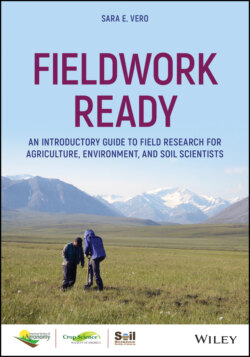Fieldwork Ready

Реклама. ООО «ЛитРес», ИНН: 7719571260.
Оглавление
Sara E. Vero. Fieldwork Ready
Table of Contents
List of Tables
List of Illustrations
Guide
Pages
Fieldwork Ready. An Introductory Guide to Field Research for Agriculture, Environment, and Soil Scientists
List of Photo Contributors
Preface
Acknowledgments
1 Introduction
What is “Fieldwork?”
Who Does Fieldwork?
Why Am I Doing this?
References
2 Types of Fieldwork. Experimental Design. Plot Experiment
Survey
Case Study
Monitoring
Sampling Design. Sampling Patterns
Event Sampling
Grab Versus Composite Sampling
Sampling for Laboratory Studies
References
3 Preparation. Site Selection. Where Do I Need to Look?
Risk Assessment
Emergency
Equipment. Tools
Consumables
Maps, Apps, and Fieldsheets
Local or Regional Maps
Sketch Maps
Plot Diagrams
Mobile Apps
Field Sheets
Photographs
Personal Protective Equipment (PPE)
Vehicles
Weather. Target Conditions
Precipitation
Humidity and Temperature
Wind
Sunlight
Soil Conditions
River Conditions
Concluding Remarks
References
4 Logistics
Communication
Your Team
The Local Community
Officials
The Buddy System
Checklists
The Importance of the “Trial Run”
In the Field
Before Fieldwork
During Fieldwork
After Fieldwork
Things Go Wrong!
Delays
Errors
Standard Operating Procedures and Quality Control
Accidents
Vandalism, Theft, and Interference
Moving On
Taking Care of Yourself in the Field
Dressing for the Field
Hydration
Food
Toilet
Moving in the Outdoors
Fatigue
Personal Safety
Stress
Accommodation
Sample Management. Packaging Samples
General Containers
Specialist Containers
Labeling
Wildlife
A Note on Insects
Domestic Animals
Zoonoses and Biosecurity
References
5 Environmental Monitoring
Resolution, Precision, Accuracy, and Hysteresis
When Should You Calibrate?
Monitoring Arrays: An Overview
Components. Logger‐Box or Enclosure
Case Study – The Importance of Logger‐Boxes
The Data‐Logger
Power
Power Calculation – Example
Sensors
Air, Soil, and Water Temperature
Stage
Humidity
Wind Speed
Rain Gauges
Volumetric Soil Water Content
Matric Potential
Step‐by‐Step Installation
Case Study – Protecting a Monitoring Array
References
6 Soil Techniques. Soil Sampling Equipment
Soil Survey
Pore‐Water Sampling
References
7 Water Techniques
Surface Water Sampling – Freshwater
Instream Parameters. Stream Width and Depth
Physico‐Chemical Parameters
Using a Multiparameter Probe
Sampling for Laboratory Analysis
Autosamplers
Sediment (Bed, Bank, and Water Column)
Groundwater Sampling
Microbial and Sterile Sampling
Soil and Sediments
Water
Sample Preservation
Filtration
Chilling and Freezing
Acidification
References
8 Plants. Finding a Slope
Randomizing Plots
Marking Field Plots
Applying Treatment to Field Plots
Phenology
Wheat
Corn
Perennial Forage Grasses
Soybeans
Vegetation Sampling
Root Sampling
Plant Height
Yield. Forage Crops
Grain Crops
References
9 Animal Techniques
Live‐Catch Trapping
Use of Trail Cameras
References
WILEY END USER LICENSE AGREEMENT
Отрывок из книги
Sara E. Vero
.....
Hydrology is perhaps notable for utilizing long‐term monitoring studies, some spanning over multiple decades. Perhaps this stems from our current and historic reliance on watercourses for abstraction, transport, and fishing and conversely, the potentially catastrophic threat of floods. The River Thames in London, U.K. is an example of long‐term monitoring and provides the longest record of water chemistry in the world. Monthly nitrate concentrations have been recorded for over 140 years, starting in 1868, accompanied by weather records for the same period and discharge since 1884. This remarkable record was investigated and documented by Howden et al. (2010), but the initiation of the monitoring was done by drinking water treatment works supplying the city of London. The engineers who established this likely had no idea that the records they began would provide insight into the environmental consequences of population increases throughout the 20th century, the advent of chemical fertilizers, World War I and II, land‐use changes, the establishment of the European Union and the water and agricultural laws brought in thereafter. While the extensive record allows each of these historical events to be examined, it also informs the design of other monitoring endeavors. For example, by evaluating the rate of hydrochemical change, the authors of that study determined that studies of shorter than 15 years would be vulnerable to error if lacking appropriate historical context. The design of legislation also depends on this evidence to guide expectations of environmental responses, which may not correspond to governance or election cycles. The definition of “long term” research varies between disciplines; however, some general consensus appears to be around 10–15 years. Lindenmayer and Likens (2010) proposed a 10‐yr threshold for ecological monitoring.
.....